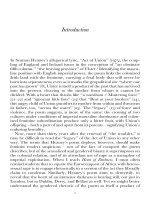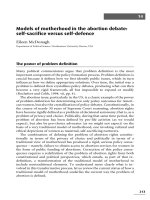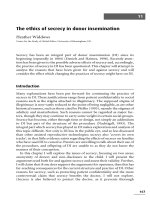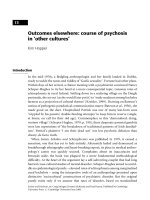representation of men in australian films
Bạn đang xem bản rút gọn của tài liệu. Xem và tải ngay bản đầy đủ của tài liệu tại đây (38.87 KB, 2 trang )
Throughout Australian film history, various Australian Male representations have been
formulated. The result of this is a variety of Male images from the rough, wholesome and
hardworking to the softer, busy, consumer orientated stereotypes. This paper will compare and
contrast the representation of men in the Australian films; "Sunday Too Far Away" (1975) and
"Priscilla Queen of the Desert"(1994) through the discussion of stereotypes, icons, the film
language and how it adds to the themes and issues raised as well as the cultural and institutional
factors contributing to the content of the films.
"Sunday Too Far Away" (1975) is a film set in 1955 about the events surrounding sheep shearing.
It faces the tedious routine and typical lifestyle of the shearers focusing on Foley, the brawling,
hard-drinking Aussie bloke. Facing the crucial issue of the day, the 9-year shearing strike, Foley
looses his job to the 'scabs'. The characters portrayed are very typically Australian Males/blokes.
Foley's image of Anti-authoritarianism shows when the owner of the ranch is looking over the
shearers, in case they cut off their "knackers and pistles". He hates this officiousness and is
anything but threatened by authority and so plays a joke on the owner. Mateship, defined as one
who is prepared to make the ultimate sacrifice for his habitual companion, to stick together
through thick and thin, (Rees Griffiths September 2002, Kalmund, D 1995 ) is obvious within the
film when the group sticks together in the strike, and loose their jobs to the 'scabs'.
Uses the eclectic character range of the film to demonstrate the masculinity and mateship of
Australian culture in the era. (A R Lantzke 1999)
Other images that depict the 'typical Aussie Male' icon of the time is the masculinity of the group-
such as the scene where Foley outcasts the man who is writing a letter to his wife, calling him a
queer, the competitiveness to shear the fastest and the most, (emphasised in the scene where Foley
and his competition are washing their clothes and race each other), the typical hard drinking
displayed in the character Garth (the oldest, longest sheep shearer of them all who consequently
dies on the station), and the independence. Slang is used to accentuate the representation of the
rough, swearing image; "You piss week bugga'", "You rotten bastard", etc. The representation of
the harshness and isolation of the station (constant long shots of the station and the open terrain)
depicts the sense of the theme mateship in that the men would bond emotionally, but don't. This is
evident in the scene were Garth is crying and Foley pats him on the back and walks out
(emphasising Garth's aloneness). Australian film, Shame(1968) represents the theme of mateship
to an intense extent. A group of young boys in a small township had such a strong sense of
mateship, and as a result, moral codes and ideology were ignored and seen by themselves and
others that their transgressions were right.
The shearing industry portrayed in the film depicts the lifestyle of the typical Aussie male. The
sense of competitiveness within the industry is apparent in a scene where a shearer puts oil in his
shoe that makes his shearer faster. The use of small talk due to the loud noise and work in the
station results in their trait of sarcasm. Their need to drink when work is over depicts this because
there is nothing else to do. Their follow workers are the only people they have to talk to which is
the characteristic of mateship. The stereotypical sense of "providers" shows that the shearers work
just for money, not lifestyle. These factors depict the typical Aussie Male through the films
institutional factors.
"Priscilla Queen of the Desert "is a road trip movie with three lady-queens, Tick/Mitzi (Hugo
Weaving), Adam/Felicia (Guy Pearce) and Bernadette (Terence Stamp) daring the Australian
outback as to the security of Sydney. Following the life of Tick/Mitzi, a lady with a wife, son and
ABBA dance routine, she challenges the gay stereotypes. The trip encounters the human cultural
differences of the close- knit townships of the northern territory, however the three outgoing cross-
dressers stick together through "thick and thin" and make it to their gig at Alice Springs.
The traits of the typical Aussie Male are represented in Priscilla Queen of the Desert however are
mainly juxtaposed or contradicted with other images. The stereotypes or images of the typical
Aussie bloke, drinking hard, swearing, humour, anti- authoritarianism, slang, individuality and
mateship (Mayer, Geoff 1991) contradict the images of femininity, emotion and an ignorance of
practical skills. A good example of this is the attempt Mitzi made to be masculine for his son with
the iconic bush hat and outback clothes juxtaposed by his identity, the way he talks and walks. The
ignorance of practical skills is shown when typical Aussie "Bob" (short stubbies, bush hat etc.)
takes a trip with them to fix up their pink bus as they journey to Alice Springs. "Well, I've had a
look around and I think we can safely assume that I now know less about motors than when I first
lifted up that that bonnety thing" (Mitzi). Their femininity is juxtapose with their drag queen
glamorous, elaborate fluoro green dresses, shot against their rugged climbing boots, standing in
the middle of the outback. Although the drag Queens hammer down the alcohol, they drink things
like 'la la drinks' and spirits compared to that of the typical stubby. It is therefore that the
stereotypical Aussie traits in Priscilla are depicted, however they are juxtaposed and contradicted
to suit the content of the film.
The time of this film is set at the emerging and need for acceptance of the gay community.
Carrying and underlying message about the need for acceptance (racial, sexual, relationship
(Smith, J 1998)
The cultural factor that the three drag queens are excepted by the Aborigines is intriguing in that
the larger townships do not accept them as do they accept aborigines.
The two films "Sunday Too Far Away" and Priscilla Queen of the Desert" represent the typical
Australian Male. However, in Priscilla Queen of the Desert the male representation is contradicted
and juxtaposed to give the illusion to the audience that the queens are not typical men and are
women. There characters are hardly ever these women, merely just men dressed up as women.
That is, the femininity vs. the masculinity traits, for example, the elaborate makeup, costume,
mannerism, drinking cocktails, friendship, emotion vs. swearing, anger, drinking, sarcasm and
fighting elements. Sunday Too Far Away looks into the typical Australian Male elements and
focuses on them to make the film relatable and emblematic of the lifestyle and lives of the
shearers. That is the brawling, hard drinking, competitive, sense of mateship,
anti-authoritarianism, and physical prowess. Therefore the two films are comparative in the sense
of they both represent the typical Australian Male, however they contrast in a sense that Priscilla
Queen of the Desert compares and contrasts the mateship and femininity aspect within it whereas
Sunday Too Far Away does not.









